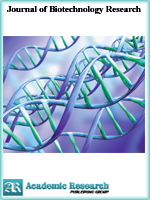Journal of Biotechnology Research
Online ISSN: 2413-3256
Print ISSN: 2413-8878
Print ISSN: 2413-8878
Quarterly Published (4 Issues Per Year)

Archives
Volume 2 Number 11 November 2016
Biological Remediation of Hazardous Pollutants Using Water Hyacinth- A Review
Authors: H. M. Saleh
Pages: 80-91
Abstract
Water hyacinth (Eichhornia crassipes, family Pontederiaceae) is extremely productive plant present on the earth and could be considered as the world’s worst aquatic plant and hence known as “Blue Devil”. It is a high water consumer plant, and has a horrible dense mats of floating green blocks. Water hyacinth causes numerous negative effects on aquatic ecosystems; as well as boat traffic, offset swimming, fishing. Moreover it covers the water column and submerged plants from sunlight. On contrary, water hyacinth is considered a candidate plant for tremendous advantages in economical industries and contaminated water treatment. Other than, it has wide acceptance in phytoremediation and it is considered as a good agent for bioaccumulation of heavy metals. In the same manner, it can be used in cleaning water streams from radionuclides. This article will present state-of-the art research and experimentation in the development of new concept and new applications of water hyacinth as a biological remediating agent for hazardous pollutants including radioactive wastes. This review will cover remediation application of water hyacinth and testing of new approaches developed in laboratories that could be more attractive for readers including students, chemists, molecular scientists and industrial researchers.



